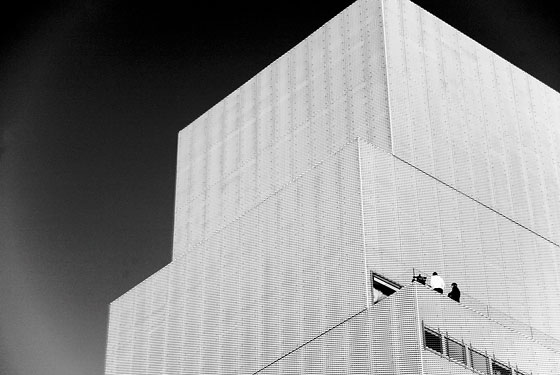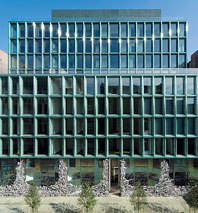
1. BEST NEW BUILDING
The New Museum of Contemporary Art
The sexy, defiant New Museum, wrapped in peekaboo aluminum, seems at first glance to be levitating over the Bowery. Sanaa’s silvered boxes are a place for art to be ungainly, rude, and uncommercial and contribute to the Bowery’s legacy of inspired idiosyncrasy. It’s the rare building that looks more magical in reality than in renderings, with texture and a purpose: tough, respectful, flexible, and totally new.
2. BEST NEW AFFORDABLE HOUSING
Via Verde
Forty years ago, affordable housing meant towers in a park. Via Verde, a 202-unit project soon to rise in the Melrose section of the Bronx, puts the park on top and the buildings underneath. A ribbon of rooftop greenery climbs from townhouses to the top of an eighteen-story tower, growing vegetables and catching rainwater. Elegantly designed by Dattner Architects and Grimshaw, it will shelter the needy while protecting the planet.
3. BEST FRENCH ARCHITECTURAL INVASION
Jean Nouvel
It’s the high-end-condo market that drives our architecture these days, and pedigreed Europeans are paying attention. The latest is Jean Nouvel, whose red-and-blue-glass pageant winner at 40 Mercer Street opened this year. Construction is also beginning on 100 Eleventh Avenue, its curve encrusted with windows like a wedge of city seen by Cézanne. But the stopper of all shows will be 53 West 53rd, the sky-impaler that will rise 75 stories above MoMA and give midtown a mighty new flourish.
4. MOST HOPEFUL VISION
Governors Island and the Battery Maritime Building
Governors Island has been choice real estate since the Dutch arrived. If only the city could figure out what to do with it: Last spring, we saw five proposals for a wonderland of boardwalks, bike paths, climbing rocks, and heated baths. The plan for the gorgeously restored Beaux-Arts Battery Maritime Building, the island’s ferry terminal, has raised eyebrows for the proposed glass hotel on top, but the building desperately needs a purpose. To let such assets molder would be spectacularly dumb.
5. MOST ALLURING BAD-WEATHER BEACON
Frank Gehry’s IAC Headquarters
Until this year, driving up the clotted West Side Highway on a rainy evening did not make you feel good about the world. But then the wrapping came off Frank Gehry’s headquarters for InterActiveCorp. The folded forms seem to liquefy in the humid air and dissipate into droplets. But only in wretched weather: In bright light, it loses most of that mystery. Should IAC ever move on, the building could be another 2 Columbus Circle: an awkward white folly looking for a use.
6. BEST NEW PREWAR
15 Central Park West
The next time you feel awash in disposable junk, take a walk past 15 Central Park West. The lobby’s luscious agate-colored marble and English oak whisper of high ceilings and appliances that could double as SUVs. Architect Robert A.M. Stern offers those who built their fortunes on intangibles—hedge funds, software, music—a way to inhabit a building with the solidity of a railroad magnate’s palazzo. Stern does not claim to be an architect of great originality; instead, he has built the best knockoff money can buy.

7. BEST MONUMENT TO MODERNISM
Philip Johnson’s Glass House
Philip Johnson built himself this impeccable box in 1949 in New Canaan, Connecticut, and populated it with articulate guests. Now, the National Trust for Historic Preservation has opened the house to the public. It’s a revelation to those who know it from photos: From within, the structure almost vanishes. Being there also answers those but-where-do-you questions. The answer is: in the cylindrical bathroom, or in the Brick House across the lawn.
8. BEST CRITICAL REAPPRAISAL
Bob and Jane, Again
Robert Moses and Jane Jacobs represent irreconcilable visions of urbanism, and praising one meant demonizing the other—until a pair of exhibits replaced caricatures with nuance. A three-part extravaganza at the Museum of the City of New York, Columbia University, and the Queens Museum made a case that Moses’s damage (the Cross Bronx Expressway) was inseparable from the good he did (the Cross Bronx Expressway again: Those cars coming off the George Washington Bridge have to go somewhere). Now the Municipal Art Society has mounted a modest exhibit exhorting New Yorkers to observe the city as closely as Jacobs did. Even Moses wouldn’t scoff.
9. BEST NEW INTERIOR
Tiffany & Co. on Wall Street
Tiffany returned to its downtown roots with a new store at 37 Wall, the former headquarters of the Trust Company of America. To preserve the landmark—and to make sure the sparkly wares aren’t overwhelmed—designer George Yabu carved the space up with glass partitions and an almost immaterial staircase. The resultant store seems to float inside the space, one era’s luxe paying homage to the last.
10. BEST STREET FURNITURE
The New Bus Shelters
A year ago, when the city announced a deal with the Spanish company Cemusa to outfit New York’s sidewalks with new bus shelters, newsstands, and public toilets, the jeers came in various forms: too expensive, never gonna happen, too much advertising. Those toilets are reportedly on the way, but in the meantime, new bus shelters are filtering into view. Slender steel frames support glass walls (only one of which bears an ad, as before) and a canopy. The structure is nearly invisible yet easy to spot: The name of the stop glows in type readable from half a block away.

Debut
Herzog & de Meuron
This Swiss firm’s first New York building has our most lavish new façade. The windows at Ian Schrager’s 40 Bond are framed in bottle-green cast glass, making it look almost handblown. Out front, a riot of aluminum curls recalls the exuberance of Spanish baroque—or of New York graffiti, from which the patterns were taken.
Stinker
The Deutsche Bank Building
Everyone wants the tower at 130 Liberty Street, damaged in the 9/11 attacks, to just go away. The building sat there for three years before insurers and the city could even agree on who’d raze it. Then crews started finding toxic mold, asbestos, and bone fragments. The ruin had been shortened from 41 stories to 26 by August, when a fire broke out, killing two firefighters and halting demolition. The sawed-off hulk still sits grimly over the site, waiting to be finished off.
